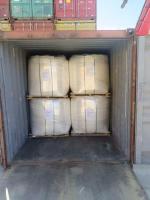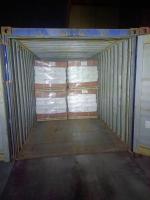Our Products
Polyacrylamide / anionic polyacrylamide of Magnafloc LT-25 equivalent model can be replace by Chinafloc A1316

Anionic polyacrylamide (Magnafloc LT-25) is a high-molecular-weight, water-soluble polymer designed to function primarily as a flocculant for solid–liquid separation. The product is part of the Magnafloc range of specialty polymers used in mining, mineral processing, and industrial wastewater treatment. The main application of anionic polyacrylamide (Magnafloc LT-25) is in processes where negatively charged polymer chains can bind with positively charged suspended particles, colloids, or precipitates, forming large, dense flocs that settle or filter rapidly.
1. Primary Role: Flocculation for Solid–Liquid Separation
The main application of anionic polyacrylamide (Magnafloc LT-25) lies in its ability to bring together fine particles suspended in water or slurry into larger aggregates (flocs). These flocs can then be removed by sedimentation, flotation, or filtration. The polymer achieves this by bridging particles through its long molecular chains and neutralizing particle surface charges in cooperation with multivalent cations present in the system. This process is critical in:
-
Thickeners
-
Clarifiers
-
Settling ponds
-
Filtration systems
In each of these units, using anionic polyacrylamide (Magnafloc LT-25) reduces turbidity, increases throughput, and improves water recovery.
2. Application in Mineral Processing
A major main application area for anionic polyacrylamide (Magnafloc LT-25) is mineral processing. In the beneficiation of ores—such as coal, iron ore, bauxite, gold, copper, and rare earths—finely ground mineral particles need to be separated from process water after grinding and classification. Without an effective flocculant, ultrafine particles can remain suspended for extended periods, slowing operations and increasing water usage.
-
Tailings Thickening – Anionic polyacrylamide (Magnafloc LT-25) accelerates the settling rate of tailings solids, increasing the clarity of the overflow water and reducing the size of thickener tanks required.
-
Process Water Recycling – Clearer overflow water enables efficient water reuse within the plant, reducing raw water demand.
-
Concentrate Dewatering – By enhancing solid capture, the polymer helps produce a higher-solids filter cake in concentrate dewatering operations.
3. Application in Industrial Wastewater Treatment
Another main application of anionic polyacrylamide (Magnafloc LT-25) is in industrial wastewater treatment, where it helps remove suspended solids from effluent streams before discharge or reuse. Many industrial processes—such as pulp and paper production, chemical manufacturing, food processing, and textile operations—generate wastewater containing a wide range of suspended matter.
-
Primary Clarification – Dosed into raw wastewater before sedimentation, the product improves particle settling, increasing solids removal efficiency.
-
Effluent Polishing – In tertiary treatment, anionic polyacrylamide (Magnafloc LT-25) works as a coagulant aid alongside metal salts like alum or ferric chloride, ensuring very low turbidity in final effluent.
-
Sludge Thickening – The polymer can also be used to pre-thicken sludge before mechanical dewatering, improving equipment performance.
4. Application in Sludge Dewatering
Sludge generated from industrial or municipal treatment plants often contains fine particles and colloids that are hard to remove mechanically. In sludge dewatering applications, anionic polyacrylamide (Magnafloc LT-25) is added before processes like belt filter pressing, centrifugation, or chamber filtration.
-
Higher Solids Content – Treated sludge cakes contain less water, reducing volume for disposal or incineration.
-
Improved Filtration Rates – Faster drainage reduces cycle times and increases throughput.
-
Cost Reduction – Lower disposal weights and volumes result in lower transport and landfill fees.
5. Performance Advantages in Its Main Application
The reasons anionic polyacrylamide (Magnafloc LT-25) is chosen for these applications include:
-
High Molecular Weight – Enables effective bridging flocculation of fine and ultrafine particles.
-
Strong Anionic Charge – Enhances binding with positively charged particle surfaces and polyvalent metal ions.
-
Fast Settling – Produces large, dense flocs that settle quickly, improving plant capacity.
-
Wide pH Range – Performs in acidic, neutral, or moderately alkaline conditions.
-
Compatibility with Coagulants – Works synergistically with aluminum- and iron-based coagulants to optimize clarification.
6. Dosing and Handling in Main Applications
For its main application, anionic polyacrylamide (Magnafloc LT-25) is generally supplied as a dry granular powder.
-
Solution Preparation – Typically prepared as a dilute aqueous solution (0.1%–0.5%) using clean water. Solutions should be mixed gently to avoid polymer chain breakage.
-
Dosing Rate – The optimal dosage depends on slurry solids concentration, particle size distribution, and water chemistry. Rates often range from 50–500 g of dry polymer per tonne of dry solids.
-
Application Point – Added where there is enough turbulence to disperse the polymer but not so much shear as to break formed flocs.
-
Storage – The dry product must be kept in sealed packaging away from moisture; prepared solutions should be used within 24 hours.
7. Environmental and Safety Considerations
While anionic polyacrylamide (Magnafloc LT-25) is considered non-toxic in its fully polymerized form, proper handling practices are essential:
-
Dust Control – Inhalation of polymer dust can be irritating; use respiratory protection and dust-free transfer systems.
-
Slip Hazard – Spilled material becomes extremely slippery when wet; clean spills immediately.
-
Environmental Fate – The polymer is not readily biodegradable but is stable and inert in the environment, with low ecotoxicity when used at recommended dosages.
8. Industries Benefiting from the Main Application
The main application of anionic polyacrylamide (Magnafloc LT-25) spans a wide range of industries:
-
Mining and Metallurgy – For thickening, clarification, and tailings water recovery.
-
Municipal Water Treatment – For sludge conditioning and dewatering.
-
Pulp and Paper – For white water clarification and fiber recovery.
-
Textiles – For dye wastewater clarification.
-
Food and Beverage – For removal of suspended organic and inorganic solids.
-
Power Generation – For ash pond water treatment and gypsum slurry dewatering.
9. Example Use Case in Mining
In an iron ore beneficiation plant, finely ground ore is processed in a flotation circuit. The tailings slurry from this process contains ultrafine iron oxides and silicate minerals. Without a flocculant, the tailings thickener would require many hours to clarify the overflow water. By adding anionic polyacrylamide (Magnafloc LT-25) at a dosage of around 150 g/t dry solids, settling times are drastically reduced, overflow turbidity is lowered to below 50 NTU, and the underflow solids concentration is increased from 30% to over 55%. This enables rapid water recycling back to the flotation plant, reducing the demand for fresh water and improving environmental performance.
Conclusion
The main application of anionic polyacrylamide (Magnafloc LT-25) is as a high-performance flocculant for solid–liquid separation in mineral processing, industrial wastewater treatment, and sludge dewatering. Its high molecular weight, strong anionic charge, and ability to produce large, rapidly settling flocs make it a versatile tool in industries where water clarity, recovery, and solids handling efficiency are critical. By improving settling rates, increasing solids capture, and enhancing dewatering, anionic polyacrylamide (Magnafloc LT-25) plays an essential role in reducing operating costs, conserving water resources, and meeting stringent environmental discharge standards.





826_small.jpg)